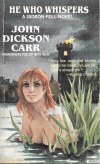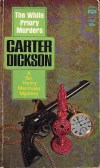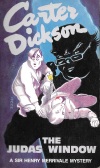When it comes to evaluating impossible crimes, there are two super obvious criteria.
- How gripping the puzzle is
- How clever the solution is
It isn’t surprising to note that the two aren’t always the same. The best solutions aren’t alway preceded by the most bewildering impossibility, and the most rapturing puzzle doesn’t alway leave you satisfied in the end. I’ve previously covered some astonishing solutions, and now I’ll be looking at five beguiling puzzles (hint: where the two lists intersect, you’ll find some killer impossible crimes).
I find that Carr’s puzzles are at their best when he beats you over the head with just how impossible they are. For page after page, he waves the crime in your face, cutting off one avenue after another until only sheer bafflement remains. You catch a glimpse of the sudden brilliant twist, only for Fell or Merrivale to explicitly rule it out mere pages later.
In contrast, Carr at times plays it subtly with the impossibility. I’ve noticed this most prominently with several earlier works. Take The Lost Gallows as an example, where the author immediately offers several outs for the puzzle of the self driving limousine. Or Castle Skull, where the story of a man’s disappearance from a train is briefly told third hand and then scarcely brought up again until the solution is revealed.
Below, I offer five puzzles that are bound to capture your interest and stimulate your imagination. I’m not necessarily commenting on how they play out, but rather how enthralling they are.
 Atop a tower in France, a man is found fatally run through with a sword. The only entrance to the tower has been under constant observation since he was last seen alive, and nobody entered or left. Suicide is ruled out, as the weapon was too long and impractical to allow for a self-inflicted would. Plus, some of the victim’s belongings which are known to have been at the scene before the crime are missing. Carr provides additional mysteries in the story, but this is the one that stays with you, even after you’ve read it.
Atop a tower in France, a man is found fatally run through with a sword. The only entrance to the tower has been under constant observation since he was last seen alive, and nobody entered or left. Suicide is ruled out, as the weapon was too long and impractical to allow for a self-inflicted would. Plus, some of the victim’s belongings which are known to have been at the scene before the crime are missing. Carr provides additional mysteries in the story, but this is the one that stays with you, even after you’ve read it.
 A detective covertly watches a suspect walk into a room with one entrance. Minutes later, a gunshot is heard inside, then another. Rushing into the room, the detective finds the man dead, shot once in the head and once in the spine. In the center of the room sits a table set with ten teacups, and on the floor a gun lays smoking. No one is hiding in the room, and there was no possible way in or out unobserved. Stranger still, both the victim’s wounds and the odd decor match the scene of an unsolved crime from two years earlier. The moment after the crime occurred is probably one of my favorite “how on earth?” moments reading Carr.
A detective covertly watches a suspect walk into a room with one entrance. Minutes later, a gunshot is heard inside, then another. Rushing into the room, the detective finds the man dead, shot once in the head and once in the spine. In the center of the room sits a table set with ten teacups, and on the floor a gun lays smoking. No one is hiding in the room, and there was no possible way in or out unobserved. Stranger still, both the victim’s wounds and the odd decor match the scene of an unsolved crime from two years earlier. The moment after the crime occurred is probably one of my favorite “how on earth?” moments reading Carr.
 When it comes to dark lore, this may be Carr’s best set up. A room cursed with horrors stretching back centuries – anyone who spends time inside alone doesn’t make it out alive. Boarded up for decades, the room is unsealed for one final experiment. A man sits locked inside for two hours, calling out a confirmation every fifteen minutes to an audience on the other side of the door. When the door is finally opened, he is found poisoned – dead for over an hour. How then has he been calling out at each checkpoint?
When it comes to dark lore, this may be Carr’s best set up. A room cursed with horrors stretching back centuries – anyone who spends time inside alone doesn’t make it out alive. Boarded up for decades, the room is unsealed for one final experiment. A man sits locked inside for two hours, calling out a confirmation every fifteen minutes to an audience on the other side of the door. When the door is finally opened, he is found poisoned – dead for over an hour. How then has he been calling out at each checkpoint?
 An actress lays bludgeoned to death in a pavilion surrounded by untouched snow. A search of the premises reveals no possible hiding place. The time of death is well after the snow started falling.
An actress lays bludgeoned to death in a pavilion surrounded by untouched snow. A search of the premises reveals no possible hiding place. The time of death is well after the snow started falling.
Carr teases it out with this one. You think that you’ve thought of a clever solution? He dispels it pages later. There are plenty of other “footprint” crimes out there, but where this one excels is how well Carr is able to draw it out. There is a lengthy investigation focused on just how the impossibility could have occurred. Carr has a knack for anticipating the conclusions you might jump to, most likely because he plants the seed in your mind. Each time I thought I had a brilliant revelation, it was dashed pages later.
 The definitive locked room murder mystery. A drugged man awakens to find himself in a perfectly sealed room with a victim stabbed to death with an arrow. Of course, we know he didn’t do it, but the evidence against him is air tight.
The definitive locked room murder mystery. A drugged man awakens to find himself in a perfectly sealed room with a victim stabbed to death with an arrow. Of course, we know he didn’t do it, but the evidence against him is air tight.
Carr starts with this simple premise and then winds the impossibility tighter and tighter as the story progresses. The crime occurs in the first chapter, and the focus on the impossibility never lets up from there. Every single chapter that follows focuses purely on the impossibility. As the story progresses, Carr unveils revelation after revelation, and yet somehow the mystery only becomes more perplexing.
It’s interesting to note that four out of five of these books are Merrivale mysteries, with only one entry being Fell. Does this mean that Merrivale stories typically had better puzzles? The thought had never occurred to me, but I have to admit that close runners up were The Unicorn Murders, She Died a Lady, and The Reader is Warned.

Just reread White Priory over Christmas – felt like a good seasonal pick – and quite liked it. The puzzle is a good one, and the atmosphere is strong too.
I’m not sure I agree with you on He Who Whispers – I think the puzzle is fine and quite memorable but I think the mystique of the central character is what sticks with you more than any of the formal puzzles presented.
LikeLike
I love White Priory, although it trudges along a bit in the middle. The solution is certainly my favorite.
He Who Whispers is certainly memorable for more than the puzzle. I suspect I’ll be putting it on an upcoming list for “five excellent plots”.
I still have quite a bit of Carr’s work to go, and I’m hoping there is enough good stuff remaining to give each of these lists a sequel.
Any thoughts on your favorite set ups for puzzles, Carr or otherwise?
LikeLike
Oh, I think there’s scope for a sequel alright. Best setups, or favorites at least, would have to include Plague Court for creepiness and hokey pseudo-history. Arabian Nights is another I like for both the structure and the sense of the absurd. I’m not sure how well regarded it is but I also enjoyed Death in Five Boxes, just because.
Beyond Carr, I’ve a soft sot for Ellery Queen’s Egyptian Cross for it’s macabre imagery and Greek Coffin for the complexity and purity.
LikeLiked by 1 person
The Judas Window is one of my favourite Carr novels.
LikeLike
It really has everything going for it, doesn’t it? The puzzle, the story, the characters, the sense of peril, the pacing. I’d place it second for the Carr works that I’ve read so far, only behind The Problem of the Green Capsule.
I should probably get around to reviewing it one of these days…
LikeLiked by 1 person
I’m obviously a massive fan of Carr’s impossibilities, but I sometimes think emphasis can be placed on them at the expense of his “normal” novels of detection. The Eight of Swords, say, has a man murdered in his study from which there is a door to the outside of the house left open (so the obvious means of murderly egress) but builds on this questions enough to fill about four books: why were the windows and doors to the room all left fuly open during a thunderstorm? Why did the deceased eat only some of the meal brought up to him, not even touching the dish highlighted as his favourite? Why did he not come out of the study to enquire what was going on when all the lights in the house went out due to a tripped fuse? Why did a visitor he’s likely to have wanted to keep secret call at the front door of the house to be admitted by the butler when the study has that door to the outside through which the visitor could easily have been admitted and so kept secret?
I almost feel as if, in terms of sheer intrigue, it’s Carr’s non-impossibilities that are the most interesting as pure puzzles. I mean, on the face of it, his impossibilities are “Holy cow, how the hell did that happen?” — wonderful, no doubt, but it’s to his credit that he took on the “standard” novel of detection and managed to find so many flourishes and angles of approach without having to resort to gimmickry. It’s almost worth doing a sequel to this list but excluding impossble crimes: his first decade alone gives The Eight of Swords, Death-Watch, The Mad Hatter Mystery, The Four False Weapons…
LikeLike
Yeah, a list of top non-impossible crimes would be interesting. I’d definitely through The Emperor’s Snuff Box in there, maybe Hag’s Nook.
Well, shoot. Now you have me questioning whether The Reader is Warned qualifies as an impossible crime. The first murder occurs in a perfectly open area, from which escape or some gimmicky distance attack would have been possible. However, the puzzle of how the victim died is so interesting, as there isn’t any known cause of death. Add in the fact that his death was predicted before hand, and it verges on impossible.
LikeLike